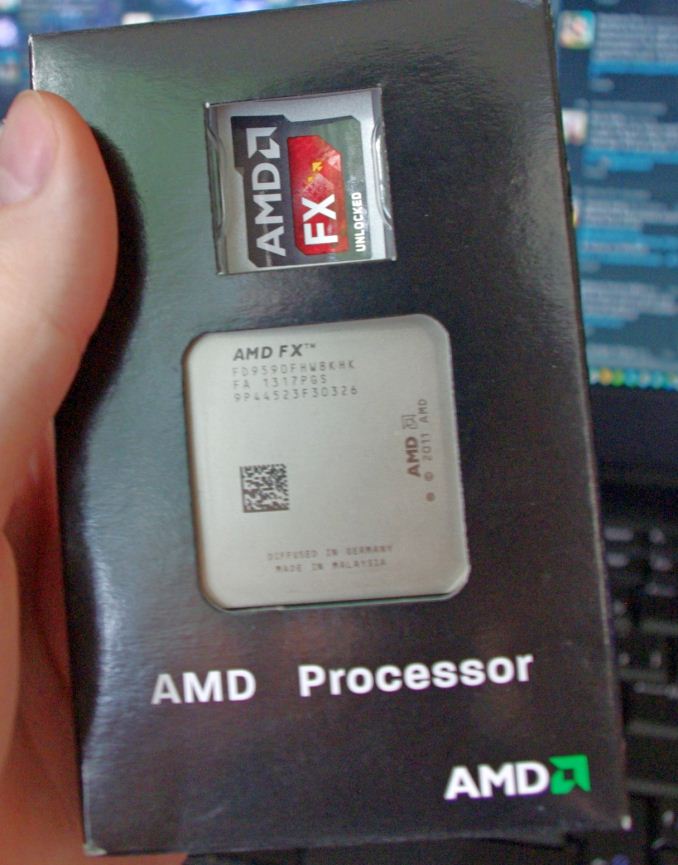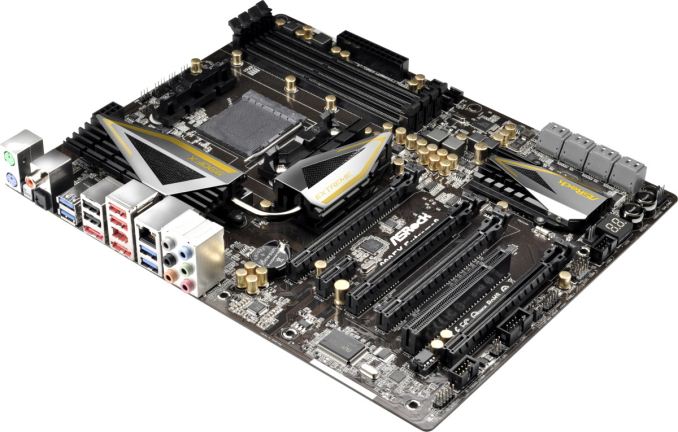AMD’s 5 GHz Turbo CPU in Retail: The FX-9590 and ASRock 990FX Extreme9 Review
by Ian Cutress on August 9, 2014 8:00 AM ESTThe AMD FX-9590
The analysis in this review shows that even a year after the OEM release of the FX-9590, and almost two years from the architecture coming to market it remains AMD’s performance part. If power consumption is not a concern, as a CPU compute and an AMD gaming CPU (especially when considering SLI) the FX-9590 is the best choice at stock speeds. On that basis alone, it makes sense that AMD should actually release it as a retail part, assuming they have enough stock. One might argue that a user could buy an FX-8350 and overclock, but if our sample CPUs were anything to go by, a user needs a fair bit of luck. The FX-9590 guarantees a 5.0 GHz turbo with a warranty.
With the retail release of the CPU, that warranty might be based on using the water cooling provided for the lifetime of the CPU. One might argue that AMD had trouble finding enough dies that could reach the frequencies and voltages for the FX-9590, and hence the delay combined with selling the SKU in select markets only.
The FX-9590 is the same Piledriver architecture as the FX-8350, which in turn was used in the A10-5800K/A10-6800K APUs, codename ‘Trinity’ and ‘Richland’ respectively. Since then, AMD has launched the Steamroller architecture modifications in the form of Kaveri APUs. The difference between a PIledriver APU and a similar frequency Steamroller APU, if we put aside the move from 32nm SOI to 28nm SHP, is around 10% for CPU performance. If that was shifted into a four-module, eight-thread CPU, it would surely be AMD’s performance part. The issue here is that AMD has almost discarded the high CPU performance arena in favor of integrated graphics. From Trinity to Kaveri, the IGP inside those APUs has improved considerably, indicating where AMD is investing its research dollars.
AMD clearly still cares about the performance market, otherwise this retail FX-9590 with water cooling would have never been pushed through to retailers. The high power consumption, the lack of a modern chipset, and the comparison to Intel CPUs in single threaded benchmarks are the main barriers to adoption. If AMD is to return to the performance market, the power consumption has to be comparable to Intel, or if it is slightly higher, the chipset has to offer something Intel cannot. Any suggestions for what that feature should be should be submitted on a postcard/in the comments.
ASRock 990FX Extreme9 Conclusion
One of the big issues surrounding AMD motherboards is their price sensitive nature. With an Intel based product, a $250-$400 motherboard is common enough to signify the expense in research or extra features. Because the AMD ecosystem, even in the high performance segment, is a cost sensitive market there is little room to move. For example, this year sees the first overclocking based motherboard for AMD APUs since the AM3+ era. So at $170, the Extreme9 could arguably be described as ‘limited’ compared to Intel standards.
The motherboard itself has specified support for 220W CPUs, something other motherboards either fail to mention or advise against completely. The native SATA 6 Gbps ports were ahead of Intel at the time, plus ASRock adds in another SATA 6 Gbps controller for good measure.
The eight USB 3.0 ports makes the Extreme9 have more USB 3.0 ports than almost every other 990FX/AM3+ motherboard ever released. This is combined with plenty of legacy support, such as separate PS/2 connectors, a PCI slot, an IEEE1394 port and an IEEE1394 header. The Intel NIC is paired with a Realtek ALC898 codec, with the PCIe layout aimed at 3-way GPU users for both Crossfire and SLI.
Aside from an updated chipset, if we were building a high-end AM3+ motherboard in 2014, I would insist on WiFi support and an upgraded audio codec to the ALC1150 at the minimum. We cannot get around the lack of PCIe 3.0 support, although moving the CPU modules from Piledriver to Steamroller along with the IO support might help with that. If we are being greedy with what we would like, I would add in M.2 support as well.
There is plenty to speculate if AMD had kept updating their high-end performance CPU line, even if the socket was not updated. As it stands, users who want SLI either look back to 990FX or invest in Intel. Users who want high multithreaded CPU performance either look back to 990FX or invest in Intel. Users who do not want processor graphics either look back to 990FX, buy an APU with the graphics disabled, or invest in Intel. AMD clearly does care about the performance market, or at least someone senior in the company does.












146 Comments
View All Comments
thejshep - Sunday, August 10, 2014 - link
But even if you more than double the wattage of an i7, you're still not approaching the wattage this cpu takesSkillztech - Friday, September 12, 2014 - link
Cause it is totally intel biasedSkillztech - Friday, September 12, 2014 - link
No need to over clock this chip at all, totally powerful. intel and the low voltage low power chips just suck at the same price range.TiGr1982 - Saturday, August 9, 2014 - link
This FX-9590 is actually the last year's product. E.g., in Canadian Canada Computers this SKU (in the version without any cooler) lays on the shelves for months and almost nobody buys it. At the same time, they have a big turnaround of Haswell Intel i7's, which speaks for itself."Re-release" of this SKU happens because AMD has nothing better to offer, so they hope to get some public attention which it better than zero public attention :)
I'm not an old man (age 32 now), but I remember the times (2005) when even Alienware top laptops were based on AMD Turions (rebranded Athlons 64) - simply because these were better than Intel's Pentium M at the time.
And, in contrast, in around last three years since Bulldozer release AMD CPU business looks poorly.
Yes, I know, APUs, OpenCL, HSA. But the CPU side of things at AMD is sad.
Da W - Monday, August 11, 2014 - link
AMD should just drop Bulldozer. That's probably what they're doing.Skillztech - Friday, September 12, 2014 - link
8 cores high multi tasking and usage with high end core hungry software leaving intel in the dust. Plus the ability to game awesome. A real CPU.Budburnicus - Saturday, January 10, 2015 - link
Intel's i7-2600K SPANKS this POS in every conceivable way! AND it is THREE years old! This is even at stock clocks, just TRY comparing this CPU in any overclock to an i7-2600K at 4.4 Ghz (and overclock that basically ANY 2600K can handle - I have mine at 4.7 and 102.3 Bclock)And with EVERY benchmark available - the 4.4 Ghz OC,ed i7-2600K will COMPLETELY blow this POS out of the water! (BTW Not only is 4.4 easy to hit, but the TDP never goes above 125 - even with my 4.7 OC, as stock TDP is only 95w!)
I USED to be an AMD "Fanboy" back in the days of Intel's Pentium 4 "Net Burst" architectural FLOP! And the Athlon XP' superior gaming performance and performance per dollar - with better overclocking!
But since PileDriver FIRST came out, I have only shuddered at the thought of this architecture even existing, let alone being pushed farther and farther! Intel KNEW Net Burst was horrible, and dumped it ASAP for first Core and then Core2 architectures - which were very competitive in all ways for their day.
On the eve of SandyBridge, once benchmarks became available it was OBVIOUS that the SandyBridge Architecture was game changing, especially since the about $350 (at release) i7-2600k - and even the $250 i5-2500K completely SPANKED even Intel's own i7-900X extreme edition CPUs whicbh cost about $1000!
Ever since AMD swallowed ATI it seems they really dropped the ball (in both courts!) Continuing this HIGHLY inefficient chip design - which is ACTUALLY only a Quad core - with just 2x the ALU's per core serving as a full "dual core" processing unit - they left out MANY components that make up a FULL core, and most importantly, while L2 cache is slightly larget than Intel's chips for the most part, the caches are MUCH slower! And a "Dual Core Unit" has twice the ALUs vying for L2 access, where L3 cache is INCREDIBLY slow at something like 200 GB/sec to ALL cores - where Intel's i7-2600K has 168 GB/sec DEDICATED PER CORE! And that is at stock speeds too!
So you have REALLY got to ask yourself, when a 3 year old Intel part - which by now is not only cheaper - but FAR more power efficient, is MUCH faster, at stock clock, than a BRAND new AMD part - which takes well over twice the power and puts out over twice the heat, WTF is th point in buying AMD?
Especially when one considers that on a CHEAP Z68 or Z77 chipset board - this three year old i7-2600K can EASILY hit 4.4 Ghz - and it will STILL be more power efficient than the AMD part - as well as multitudes faster in EVERY way that truly matters - this just seem sad for AMD...
They are eating more power, and crapping less performance - even per $! Unless you really want a bargain basement gaming PC - then an A10 APU with a cheap GFX card will be cheaper than an Intel build with similar performance (but we are talking $500 and less for a entirely new build!)
So this FX just represents a sad bit of AMD history, sure the hardcore "fan-boys" will cling tightly to their AMD parts they have invested money into - but (and there is always that BUT) everything about this new FX chip is far behind, and the ONLY reason one should even consider purchasing one is if they already own a good Socket AM3+ mobo - for new builds? AVOID AMD FX CHIPS LIKE THE PLAGUE!
SlowSpyder - Saturday, August 9, 2014 - link
For those who are running their CPU's at 100% load 24 hours a day, seven days a week, 365 days a year, this isn't the right CPU. That's likely a quite small population of people. There are cons to the FX 9xxx CPU's to be sure, but I don't think what are often over-blown energy usage costs are one of them.MatthiasP - Saturday, August 9, 2014 - link
The real problem is, there is not a single pro for this processor.SlowSpyder - Saturday, August 9, 2014 - link
For someone looking to build a new system, probably not a lot of pros. For AM3+ owners looking for an upgrade from a lower part and guaranteed clocks, there could be some value in this processor.